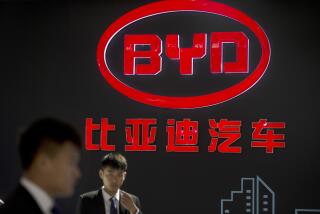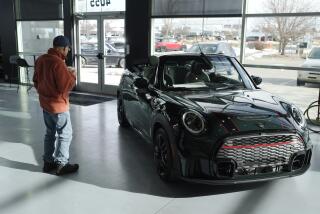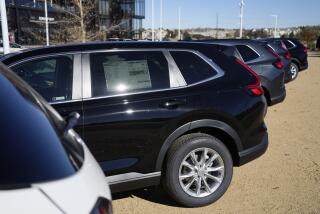Will the Drive to ‘Buy American’ Endure?
- Share via
LOS ANGELES — Don Wright’s syndicated cartoon shows a domestic sedan with a bumper sticker announcing: “I Buy American.” In the second panel, the bumper falls off.
So did advertising in several New York and Ohio newspapers that ran Wright’s cartoon as dealers killed their car ads in protest.
In Michigan last week, Oakland County Circuit Court Judge Hilda Gage told a recidivist speeder that his suspended license would be restored for business travel if he promised to drive only American-built cars. The defendant--ironically a Soviet emigre and no stranger to judicial intransigence--swore a new oath of allegiance and is considering the purchase of a Ford Taurus.
Judge Gage said her star-spangled order was motivated “by a sense of patriotism and a concern for the economy.” Then she drove home in an Oldsmobile.
As goes Michigan, so goes the rest of the nation, as a lusty case of Yankee Doodle Dandyism stirs in vocal, and some say ephemeral, support of a domestic industry and an endangered species: the American automobile.
Among the new nationalists, say analysts, is a cadre of younger purchasers who, if not actually ready to buy, certainly are thinking hard about Buying American. Although early January sales of domestic cars continue to show slippage, they say consumers are reacting on two emotional fronts:
* They have been excited by Japan bashing in Detroit and incensed by retaliatory rhetoric from Tokyo. Monday, a Japanese politician accused American auto workers of sliding through Mondays and Fridays, virtually creating a three-day work week.
* Consumers are frightened by a listless U.S. economy and angered by growing, apparently intractable, competition from Japan. They are upset by the apparent impotence of President Bush and business leaders, whose recent trade visit to Tokyo won only token concessions from the Japanese auto industry.
Above all, say the experts, more car buyers seem to be accepting the growing wisdom that many domestic cars are nowhere near as bad as they used to be--and some imported cars aren’t as good as they’re cracked up to be.
That also might be closer to reality than Toyota would like us to believe.
“I think there really is a crop of (domestic) products worthy of buyer attention,” says Chris Cedergren of Thousand Oaks, senior vice president of the AutoPacific Group of auto industry consultants. He also admits to driving a licorice-black BMW535i. “But I’m thinking of buying a Ford Explorer as a second car. It (Explorer) is a barn-burning success out here in California with a (sales) backlog nationally.
“The new Cadillac Seville and Eldorado are worth looking at . . . I like the Oldsmobile 88 and its styling for personal reasons.”
J. P. Vettraino, West Coast editor for AutoWeek magazine, test drives an average 50 cars each year and 35% are domestics. He also covers auto industry shows from Detroit to Tokyo. He likes Ford’s Explorer and Taurus sedan, Cadillac’s 1992 Seville and Chrysler’s minivans.
“As a package, the Chrysler minivans are the best ones out there,” he says. “The Japanese might be better in certain aspects, but as a package the Chrysler minivan has it.”
So, he says, does Ford’s Crown Victoria: “A car in the classic American idiom, but updated with improved brakes, steering and handling.”
Then there’s Jeep Cherokee: “An obvious hit as a four-door utility vehicle with good power and well engineered.”
Also the Chevrolet Corvette: “What it lacks in refinement, it more than makes up for in brute power, the sheer pleasure of driving and its macho image. And don’t forget that other American sports car, the Dodge Viper.”
But while some observers believe the current wave of patriotism will improve sales for the Big Three, others say the increase will be slight, even fleeting.
“I don’t think the Buy American thing is going to last very long or make a noticeable difference,” says Peter Brown, editor of the Detroit-based Automotive News. Patriotism, he says, does not motivate a market. “If it did, we would have seen it last year after Desert Storm.”
During that period, America was a world champion, high on military and technological supremacy, while Japan was under international criticism for its lukewarm support of military intervention in the Persian Gulf.
“We didn’t Buy American then and we won’t now,” Brown adds. “There is some evidence that people might be delaying buying a Japanese car because they don’t think this is the time to be driving into the neighborhood with a new (Toyota) Camry.
“But they’re not going to be out buying a (Chevrolet) Lumina either.”
Other industry analysts and magazine writers say that by not considering domestic automobiles, buyers could be shortchanging their own budgets. American cars have made quantum leaps since the chromium era of the late ‘70s when, notes Vettraino, “huge V-8s were giving only 130 horsepower . . . this was a sorry mess of boulevard cars with lots of power and sheet metal, but poor brakes, poor handling.
“We were doing less with more. While the Japanese were doing more with less.”
Today, say the experts, gaps in quality, technology, styling and design remain between domestic and imported cars. But the separation is small and closing. Anti-lock brakes, multivalve engines and automatic suspension systems are no longer a monopoly of Asian and European automobiles.
“In every (market) segment, there are very competitive domestic vehicles that enjoy a price advantage,” comments editor Brown.
The heftiest advantage, says Frank Peiler, executive vice president of Consumer Guide, a Chicago-based publisher of auto reviews, is with full-size and luxury domestic cars such as the Buick Park Avenue, Oldsmobile Ninety-Eight, Cadillac and Lincoln. The retail price of a fully equipped Park Avenue Ultra, for example, is $29,000. A Lexus LS400 luxury four-door from Japan has a sticker price of $42,500.
“I’m very impressed by GM these days,” Peiler says. “Their cars are getting great gas mileage, and they’ve got a four-speed automatic transmission that in my opinion is the finest in the world.”
John Casesa, an automotive analyst with Wertheim Schroder & Co., a New York brokerage firm, says “domestic cars will be news for Americans who haven’t been in a Big Three showroom for years.
“I look at the Plymouth Acclaim and Dodge Spirit, the Cadillacs with the 4.9 (liter) engine and all are very reliable cars. Cadillacs--I know for a fact from industry surveys I shouldn’t have seen--are more reliable than Japanese cars.”
Yet the sins of Detroit’s past, observers agree, will die hard.
And Brown believes that not everyone is aware of the drastic improvement in domestic cars. Some don’t even care. Their minds were made up years ago, and the wisdom of their decisions upheld by smaller, more economical, better handling and generally more reliable imports.
Cedergren says that having built a new reputation for reliability and efficiency, Detroit must now concentrate on quality.
“Quality isn’t reliability, it isn’t zero defects,” he believes. “It is value, performance, image and the overall craftsmanship.”
It has to do with the solid thump of a closing door. Or a turn signal stalk that moves firmly without flopping. Or the feel of a key that slides into a lock without threatening to snap.
“They might seem insignificant things,” Cedergren notes. “But to a consumer they are very, very important.”
Meanwhile, the bilateral mudslinging continues.
Monday, Prime Minister Kiichi Miyazawa of Japan told members of his government that Americans “lacked the work ethic.”
Yet that statement found favor with one American manager.
Noted a Ford representative, obviously begging anonymity: “If Lee Iaccoca will shut up and if the Japanese will keep talking, it (Buy American) might continue.”






